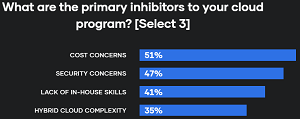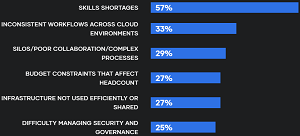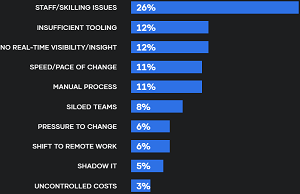News
Multi-Cloud Is New Normal, Survey Says, but Skills Shortage Persists
HashiCorp published its first-ever cloud strategy survey, finding that multi-cloud is the new normal despite being hindered by lack of multi-cloud skills and overall cloud security concerns.
In announcing the survey report, HashiCorp highlighted the finding that 76 percent of respondents are already using multi-cloud implementations, while 86 percent expect to do so within two years.
"This overwhelming majority of respondents reported using more than one public or private cloud, making multi-cloud no longer some vague or aspirational goal, but rather their everyday reality," the company said in introducing the HashiCorp State of Cloud Strategy Survey.
However, those multi-cloud adoption numbers might be skewed by the nature of the survey, which did not poll a random sampling of some sort, but rather targeted more than 300,000 people in the opt-in contact database of HashiCorp, which describes itself as "the leader in infrastructure automation for multi-cloud environments." Thus it appears likely that the 3,205 responses garnered come from people/organizations already invested or interested in multi-cloud.
Whatever the adoption status of multi-cloud implementations in the "real" world, respondents to the HashiCorp survey identify a skills shortage as holding things back on multiple fronts, including primary inhibitors to cloud programs:
 [Click on image for larger view.] What are the primary inhibitors to your cloud program? (source: HashiCorp).
[Click on image for larger view.] What are the primary inhibitors to your cloud program? (source: HashiCorp).
the most significant challenges hindering the ability to operationalize multi-cloud:
 [Click on image for larger view.] What are the most significant challenges hindering your ability to operationalize multi-cloud? (source: HashiCorp).
[Click on image for larger view.] What are the most significant challenges hindering your ability to operationalize multi-cloud? (source: HashiCorp).
and the most significant cloud challenges for the security component of cloud efforts:
 [Click on image for larger view.] What are the most significant cloud challenges for the security component of your cloud efforts? (source: HashiCorp).
[Click on image for larger view.] What are the most significant cloud challenges for the security component of your cloud efforts? (source: HashiCorp).
"More than half (57 percent) of respondents said a shortage of the proper skills was a top-three challenge, hindering their organization's ability to operationalize multi-cloud," the survey said. "That was almost twice the percentage for the next most popular choices: inconsistent workflows across cloud environments (33 percent) and teams working in silos with little collaboration (29 percent). Similarly, when asked about inhibitors to their cloud programs, respondents listed a lack of in-house skills or expertise to manage different cloud environments as the third most often-named issue (41 percent), trailing only cost (51 percent) and security (47 percent) concerns."
One perhaps surprising finding seems to contradict the widespread belief that the COVID-19 pandemic has driven organizations to use cloud computing more, for remote work and other scenarios. Some 46 percent of respondents said that the pandemic had not affected their shift to cloud or multi-cloud adoption, while another 19 percent said it had only a low impact and accelerated the shift by just six to 12 months.
On the other hand, various articles on Virtualization & Cloud Review that support that widespread belief include:
Seemingly addressing that apparent contradiction, HashiCorp said: "These results may seem counterintuitive, but they show that cloud adoption efforts were important and widely underway before the pandemic -- and are likely to continue long after. On the other hand, only 32 percent of large enterprises said COVID-19 had no impact on their digital transformation timelines -- the rest saw it push things forward."
Other highlights of the report include:
- AWS Remains the Top Cloud Provider: AWS holds a commanding cloud market share across every region, industry and organization size. Despite worries about vendor lock-in, that dominance isn't expected to fade.
- Multi-Cloud Brings Multiple Benefits, Led by Digital Transformation: Top answers to the question "What are the business and technology factors driving your multi-cloud adoption?" include digital transformation (34 percent), avoid single cloud vendor lock-in (30 percent), cost reduction (28 percent) and scaling (25 percent).
- Multi-Cloud Is Tightly Connected to Other Modern Technology Initiatives: In large organizations, multi-cloud usage is typically correlated with other initiatives such as infrastructure as code, container orchestration, application delivery automation, secrets management, service mesh and more. And adoption of many of those correlated technologies is expected to almost double in the next year.
- Cloud Challenges Across Infrastructure Layers: Cloud challenges are consistent across industries and geographies, as well as provisioning, networking, application deployment and security component -- with staff/skilling issues cited as the top concern for each. Top answers to the question "What are the most significant cloud challenges for each component of your cloud efforts?" include staff/skilling issues (20 percent), manual processes (17 percent), speed/pace of change (14 percent) and uncontrolled costs (12 percent).
- Open Source Tools Are the Most Popular Option: Building on open source software is the most popular choice for infrastructure automation tools across all infrastructure categories. But running OSS security tools yourself -- while still the number one option -- is significantly less popular than for other cloud components. The security arena also had the highest percentage of respondents who buy commercial tools.
HashiCorp it will publish deep dives into different aspects of the survey, ranging from the challenges facing specific components of cloud infrastructure to breaking down the survey results by industry and geography.
About the Author
David Ramel is an editor and writer at Converge 360.